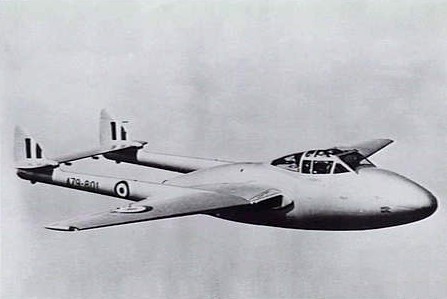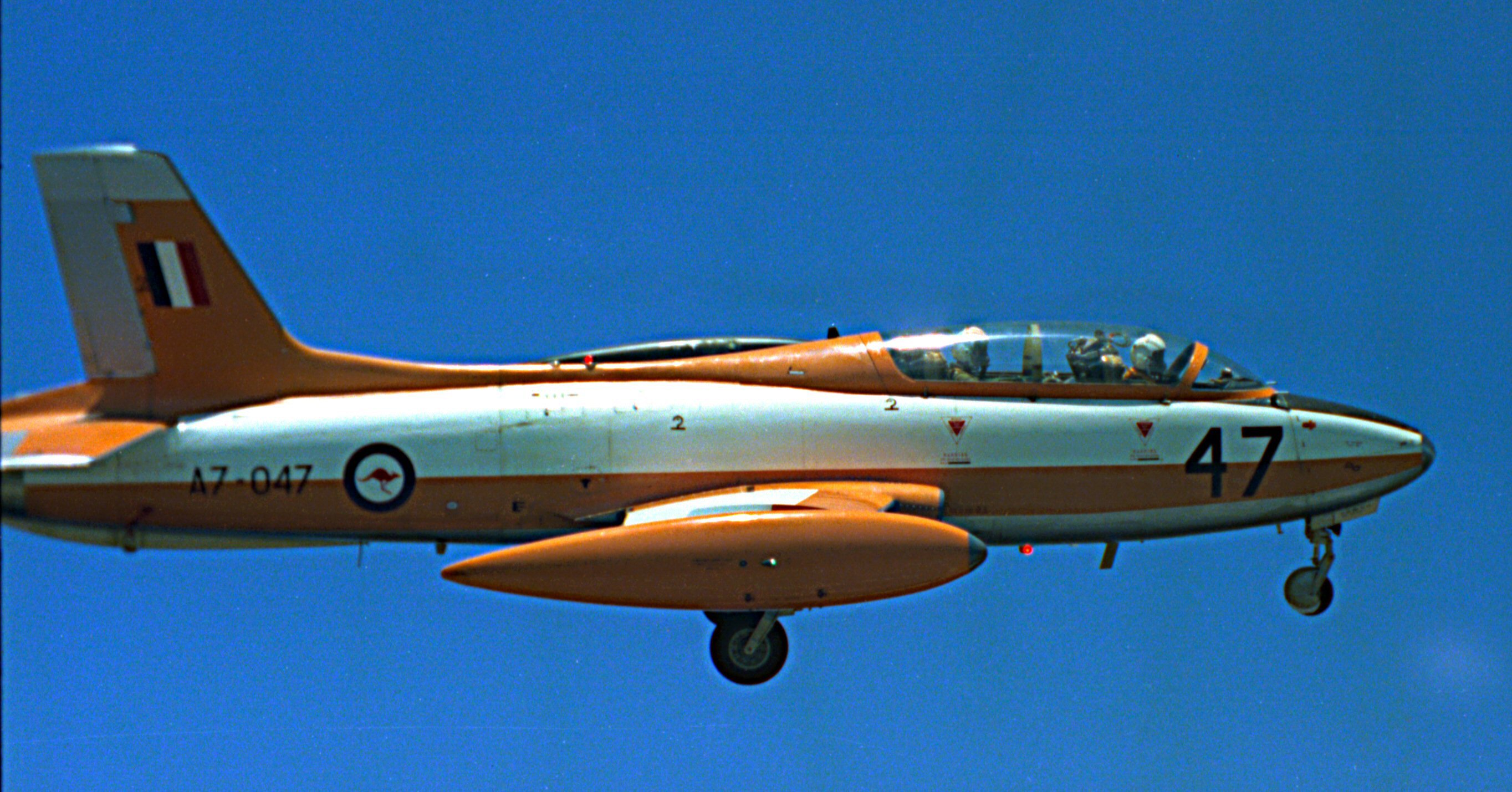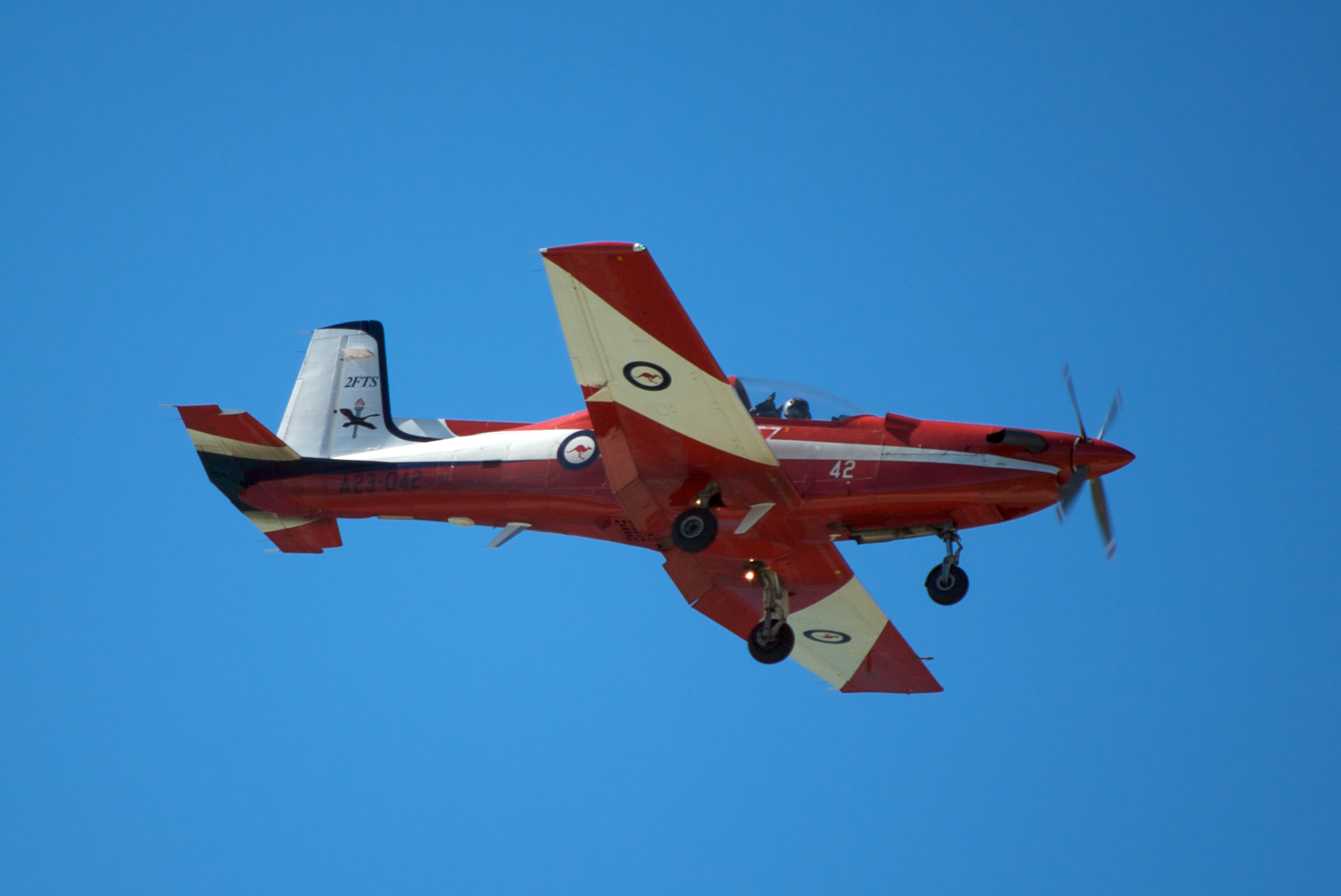No. 2 Flying Training School RAAF on:
[Wikipedia]
[Google]
[Amazon]
No. 2 Flying Training School (No. 2 FTS) is the main flying training school of the
 In August 1947, No. 1 Flying Training School, which had been known as No. 1 Service Flying Training School under the wartime
In August 1947, No. 1 Flying Training School, which had been known as No. 1 Service Flying Training School under the wartime
 On 31 December 1968, No. 1 AFTS was disbanded at Pearce, reforming as No. 2 Flying Training School (No. 2 FTS) on 1 January 1969. At the same time, No. 1 BFTS was disbanded at Point Cook and reformed there as No. 1 FTS. The first Macchi course at No. 2 FTS graduated in September the same year. By this time the Vampires had all been retired and ground staff were fully dedicated to work on the Italian jets, which nevertheless proved a more challenging proposition to maintain than its predecessor. The introduction of the Macchi led to a brief flirtation with "all-through jet training" in the Air Force between 1969 and 1971, as it was expected to reduce the time necessary to turn out high-quality aviators. The practice was dropped after ten courses, being labelled "an expensive way of finding out that some pupils lacked the aptitude to become military pilots".
On 31 December 1968, No. 1 AFTS was disbanded at Pearce, reforming as No. 2 Flying Training School (No. 2 FTS) on 1 January 1969. At the same time, No. 1 BFTS was disbanded at Point Cook and reformed there as No. 1 FTS. The first Macchi course at No. 2 FTS graduated in September the same year. By this time the Vampires had all been retired and ground staff were fully dedicated to work on the Italian jets, which nevertheless proved a more challenging proposition to maintain than its predecessor. The introduction of the Macchi led to a brief flirtation with "all-through jet training" in the Air Force between 1969 and 1971, as it was expected to reduce the time necessary to turn out high-quality aviators. The practice was dropped after ten courses, being labelled "an expensive way of finding out that some pupils lacked the aptitude to become military pilots".
 The school began replacing its Macchis with
The school began replacing its Macchis with
at RAAF Museum. Retrieved on 12 February 2011. Since 2006, No. 2 FTS has been under the command of Air Training Wing, a component of Air Force Training Group, headquartered atAir Force Training Group
at Royal Australian Air Force. Retrieved on 16 February 2011. RAAF and
Royal Australian Air Force
"Through Adversity to the Stars"
, colours =
, colours_label =
, march =
, mascot =
, anniversaries = RAAF Anniversary Commemoration ...
(RAAF). Formed under its present name in 1969, it is located at RAAF Base Pearce
RAAF Base Pearce is the main Royal Australian Air Force (RAAF) military air base in Western Australia. The base is located in Bullsbrook, north of Perth. It is used for training by the RAAF and the Republic of Singapore Air Force.
Pearce is ...
, Western Australia. The unit operates a fleet of Pilatus PC-21
The Pilatus PC-21 is a turboprop-powered advanced trainer with a stepped tandem cockpit. It is manufactured by Pilatus Aircraft of Switzerland.
Development
In November 1997 Pilatus flew a modified PC-7 Mk.II in order to test improvements for ...
turboprop trainers. No. 2 FTS traces its origins to the post-war re-establishment of the Air Force's original cadet training unit, No. 1 Flying Training School (No. 1 FTS), at RAAF Point Cook
RAAF Williams is a Royal Australian Air Force (RAAF) military air base set across two locations, at Point Cook and Laverton, located approximately south-west of the Melbourne central business district in Victoria, Australia. Both establishm ...
, Victoria, in 1947. Following reorganisation of aircrew training in 1951–52, No. 1 FTS was renamed No. 1 Applied Flying Training School (No. 1 AFTS), and began specialising in advanced flight instruction on CAC Wirraway
The CAC Wirraway (an Aboriginal word meaning "challenge") was a training and general purpose military aircraft manufactured in Australia by the Commonwealth Aircraft Corporation (CAC) between 1939 and 1946. It was an Australian development of ...
s. It relocated to RAAF Base Pearce in 1958, where it converted to De Havilland Vampire
The de Havilland Vampire is a British jet fighter which was developed and manufactured by the de Havilland, de Havilland Aircraft Company. It was the second jet fighter to be operated by the Royal Air Force, RAF, after the Gloster Meteor, and ...
jet trainers. In January 1969, the school was reformed as No. 2 FTS, having the previous year begun replacing the Vampires with Macchi MB-326Hs. The Macchis were themselves replaced by the PC-9 beginning in 1989.
History
Origins and early years as No. 1 AFTS
 In August 1947, No. 1 Flying Training School, which had been known as No. 1 Service Flying Training School under the wartime
In August 1947, No. 1 Flying Training School, which had been known as No. 1 Service Flying Training School under the wartime Empire Air Training Scheme
The British Commonwealth Air Training Plan (BCATP), or Empire Air Training Scheme (EATS) often referred to as simply "The Plan", was a massive, joint military aircrew training program created by the United Kingdom, Canada, Australia and New Zea ...
and disbanded in 1944, was re-established at RAAF Station Point Cook
RAAF Williams is a Royal Australian Air Force (RAAF) military air base set across two locations, at Point Cook and Laverton, located approximately south-west of the Melbourne central business district in Victoria, Australia. Both establishm ...
, Victoria. Responsible at that stage for all flight instruction of air cadets, its aircraft initially included one Avro Anson
The Avro Anson is a British twin-engined, multi-role aircraft built by the aircraft manufacturer Avro. Large numbers of the type served in a variety of roles for the Royal Air Force (RAF), Fleet Air Arm (FAA), Royal Canadian Air Force (RCAF) a ...
, two De Havilland Tiger Moth
The de Havilland DH.82 Tiger Moth is a 1930s British biplane designed by Geoffrey de Havilland and built by the de Havilland Aircraft Company. It was operated by the Royal Air Force (RAF) and other operators as a primary trainer aircraft. ...
s, and 55 CAC Wirraway
The CAC Wirraway (an Aboriginal word meaning "challenge") was a training and general purpose military aircraft manufactured in Australia by the Commonwealth Aircraft Corporation (CAC) between 1939 and 1946. It was an Australian development of ...
s.RAAF Historical Section, ''Units of the Royal Australian Air Force'', pp. 38–39 In response to demands for more aircrew to fulfil Australia's commitments to the Korean War
, date = {{Ubl, 25 June 1950 – 27 July 1953 (''de facto'')({{Age in years, months, weeks and days, month1=6, day1=25, year1=1950, month2=7, day2=27, year2=1953), 25 June 1950 – present (''de jure'')({{Age in years, months, weeks a ...
and Malayan Emergency
The Malayan Emergency, also known as the Anti–British National Liberation War was a guerrilla war fought in British Malaya between communist pro-independence fighters of the Malayan National Liberation Army (MNLA) and the military forces o ...
, RAAF flying training underwent significant change in 1951–52. No. 1 Initial Flying Training School was raised at Archerfield, Queensland, to impart students with general aeronautical and military knowledge, after which they received flight grading on Tiger Moths. Graduates went on to the newly formed No. 1 Basic Flying Training School (No. 1 BFTS) at Uranquinty
Uranquinty is a small town approximately south of Wagga Wagga, in the Riverina region of New South Wales, Australia. The population of the town, often referred to as "Quinty", is 909.
Uranquinty was used as the railway village when the railw ...
, New South Wales, where they underwent further instruction, first on Tiger Moths and then on Wirraways. Finally they transferred to No. 1 FTS, which was renamed No. 1 Applied Flying Training School (No. 1 AFTS) in March 1952, for advanced instruction and combat training on Wirraways.Stephens, ''The Royal Australian Air Force'', pp. 199–200
In May 1958, No. 1 AFTS relocated to RAAF Base Pearce
RAAF Base Pearce is the main Royal Australian Air Force (RAAF) military air base in Western Australia. The base is located in Bullsbrook, north of Perth. It is used for training by the RAAF and the Republic of Singapore Air Force.
Pearce is ...
, Western Australia, to re-equip with De Havilland Vampire
The de Havilland Vampire is a British jet fighter which was developed and manufactured by the de Havilland, de Havilland Aircraft Company. It was the second jet fighter to be operated by the Royal Air Force, RAF, after the Gloster Meteor, and ...
jet trainers. Pearce's long runway made it more suitable for jet operations than the airfield at Point Cook.RAAF Historical Section, ''Units of the Royal Australian Air Force'', pp. 40–42 No. 1 AFTS's place at Point Cook was taken by No. 1 BFTS, which transferred from Uranquinty. Fourteen Vampires were delivered to Pearce by July, and all fourteen students on the first course at No. 1 AFTS graduated at the end of the year, making them the first RAAF cadets to do so on jet aircraft. In addition to flying training, the school was responsible for search and rescue
Search and rescue (SAR) is the search for and provision of aid to people who are in distress or imminent danger. The general field of search and rescue includes many specialty sub-fields, typically determined by the type of terrain the search ...
operations off the West Australian coast, utilising C-47 Dakota
The Douglas C-47 Skytrain or Dakota (Royal Air Force, RAF, Royal Australian Air Force, RAAF, Royal Canadian Air Force, RCAF, Royal New Zealand Air Force, RNZAF, and South African Air Force, SAAF designation) is a airlift, military transport ai ...
s that were later augmented by a UH-1 Iroquois
The Bell UH-1 Iroquois (nicknamed "Huey") is a utility military helicopter designed and produced by the American aerospace company Bell Helicopter. It is the first member of the prolific Huey family, as well as the first turbine-powered helico ...
helicopter. By the mid-1960s, the aging Vampires were increasingly prone to system failures and the RAAF began evaluating replacements. A team led by Air Commodore Brian Eaton
Air Vice-Marshal Brian Alexander Eaton, (15 December 1916 – 17 October 1992) was a senior commander in the Royal Australian Air Force (RAAF). Born in Tasmania and raised in Victoria, he joined the RAAF in 1936 and was promot ...
selected the Italian Macchi MB-326H as the RAAF's new jet trainer, as it met all requirements, could be licence-built by the Commonwealth Aircraft Corporation
The Commonwealth Aircraft Corporation (CAC) was an Australian aircraft manufacturer. The CAC was established in 1936, to provide Australia with the capability to produce military aircraft and engines.
History
In 1935 the Chief General Manager ...
in Australia, and was relatively inexpensive. It began replacing the Vampires of No. 1 AFTS in May 1968.
Reformation and recent years as No. 2 FTS
 On 31 December 1968, No. 1 AFTS was disbanded at Pearce, reforming as No. 2 Flying Training School (No. 2 FTS) on 1 January 1969. At the same time, No. 1 BFTS was disbanded at Point Cook and reformed there as No. 1 FTS. The first Macchi course at No. 2 FTS graduated in September the same year. By this time the Vampires had all been retired and ground staff were fully dedicated to work on the Italian jets, which nevertheless proved a more challenging proposition to maintain than its predecessor. The introduction of the Macchi led to a brief flirtation with "all-through jet training" in the Air Force between 1969 and 1971, as it was expected to reduce the time necessary to turn out high-quality aviators. The practice was dropped after ten courses, being labelled "an expensive way of finding out that some pupils lacked the aptitude to become military pilots".
On 31 December 1968, No. 1 AFTS was disbanded at Pearce, reforming as No. 2 Flying Training School (No. 2 FTS) on 1 January 1969. At the same time, No. 1 BFTS was disbanded at Point Cook and reformed there as No. 1 FTS. The first Macchi course at No. 2 FTS graduated in September the same year. By this time the Vampires had all been retired and ground staff were fully dedicated to work on the Italian jets, which nevertheless proved a more challenging proposition to maintain than its predecessor. The introduction of the Macchi led to a brief flirtation with "all-through jet training" in the Air Force between 1969 and 1971, as it was expected to reduce the time necessary to turn out high-quality aviators. The practice was dropped after ten courses, being labelled "an expensive way of finding out that some pupils lacked the aptitude to become military pilots".
 The school began replacing its Macchis with
The school began replacing its Macchis with Pilatus PC-9
The Pilatus PC-9 is a single-engine, low-wing tandem-seat turboprop training aircraft manufactured by Pilatus Aircraft of Switzerland. Designed as a more powerful evolution of the Pilatus PC-7, the PC-9's first flight was made in May 1984 after ...
turboprop trainers in July 1989, the process being completed in September 1991. The jets continued to be operated by Pearce's No. 25 Squadron; some of No. 2 FTS's PC-9s also served temporarily with the squadron as fatigue issues took their toll on the Macchis. As the CT-4A Airtrainers of Point Cook were phased out and No. 1 FTS disbanded in 1992–93, all-through flight training on the PC-9 began.CT-4A Airtrainerat RAAF Museum. Retrieved on 12 February 2011. Since 2006, No. 2 FTS has been under the command of Air Training Wing, a component of Air Force Training Group, headquartered at
RAAF Williams
RAAF Williams is a Royal Australian Air Force (RAAF) military air base set across two locations, at Point Cook and Laverton, located approximately south-west of the Melbourne central business district in Victoria, Australia. Both establishm ...
Laverton Base.at Royal Australian Air Force. Retrieved on 16 February 2011. RAAF and
RAN
Ran, RaN and ran may refer to:
Arts and entertainment
* ''Ran'' (film), a 1985 film directed by Akira Kurosawa
* "Ran" (song), a 2013 Japanese song by Luna Sea
* '' Ran Online'', a 2004 MMORPG (massively multiplayer online role playing game)
* ...
pilots undertake a 34-week training course at the school, following their ''ab initio
''Ab initio'' ( ) is a Latin term meaning "from the beginning" and is derived from the Latin ''ab'' ("from") + ''initio'', ablative singular of ''initium'' ("beginning").
Etymology
Circa 1600, from Latin, literally "from the beginning", from ab ...
'' instruction on CT-4B Airtrainers at the Australian Defence Force Basic Flying Training School
The Australian Defence Force Basic Flying Training School (BFTS) was located in Tamworth in northern New South Wales. It was run by BAE Systems Flying Training Academy, which conducted tri-service flight screening and basic flying training fo ...
in Tamworth, New South Wales.
Notes
References
* * * {{RAN FAA squadrons, state=collapsed 2 Military units and formations established in 1969 Military Units in Western Australia